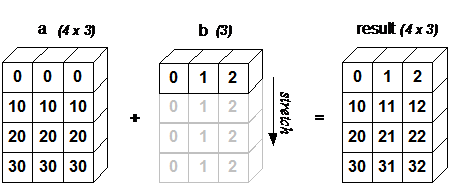Numpy 中的 Braodcast 机制理解
[TOC]
原文见
https://numpy.org/doc/stable/user/basics.broadcasting.html
简介
简单来说,broadcast就是两个维度不同的输入数组在element-wise的运算基础上,运算后输出的数组会有传播(broadcast)机制。 有两点需要注意:
- 需要是element-wise运算,具体什么是element-wise的运算,可以搜索。
- 维度不同的两个数组,有一定的规则,不能是随便两个维度不同的数组。
下面讲解以下具体的规则
四个原则
这里直接放原文:
- All input arrays with ndim smaller than the input array of largest ndim, have 1’s prepended to their shapes.
- The size in each dimension of the output shape is the maximum of all the input sizes in that dimension.
- An input can be used in the calculation if its size in a particular dimension either matches the output size in that dimension, or has value exactly 1.
- If an input has a dimension size of 1 in its shape, the first data entry in that dimension will be used for all calculations along that dimension. In other words, the stepping machinery of the ufunc will simply not step along that dimension (the stride will be 0 for that dimension).
用我们看得懂的解释来说:
- 所有输入的数组,会向维度最大的数组看齐,其他维度更小的数组,没有的维度用1补齐。就是说A(2,3,4,1)和B(3, 4, 5)相加,那么A是维度最大的数组,B是维度小的数组, 那么B就会向A看齐,第一个维度会变成(1, 3, 4, 5),然后和A相加。
- 运算后的输出数组的大小(size),是所有输入数组最大的维度值。这个如下图所示

- 要满足broadcast的运算要求,输入的数组的维度要么是和另外的数组匹配,要么是在该维度上大小为1。比如上述的A和B相加,A的第四个维度为1,B看齐之后,第四维度为5,所以A可以和B相加 是因为在该维度上大小为1.对于第二和第三个维度,因为大小匹配/相等,所以也可以相加。
- 维度为1的输入数组,该维度上的后续运算都用第一组值。

来看更为一般的broadcasting rules:
当操作两个array时,numpy会逐个比较它们的shape(构成的元组tuple),只有在下述情况下,两arrays才算符合broadcast的机制:
- 相等
- 其中一个为1,(进而可进行拷贝拓展已至,shape匹配)
对于输出的数组的shape,则是两个array的shape在每个维度上最大值的组合。
运用例子
A (4d array): 8 x 1 x 6 x 1
B (3d array): 7 x 1 x 5
Result (4d array): 8 x 7 x 6 x 5
A (2d array): 5 x 4
B (1d array): 1
Result (2d array): 5 x 4
A (2d array): 5 x 4
B (1d array): 4
Result (2d array): 5 x 4
A (3d array): 15 x 3 x 5
B (3d array): 15 x 1 x 5
Result (3d array): 15 x 3 x 5
A (3d array): 15 x 3 x 5
B (2d array): 3 x 5
Result (3d array): 15 x 3 x 5
A (3d array): 15 x 3 x 5
B (2d array): 3 x 1
Result (3d array): 15 x 3 x 5
文档信息
- 本文作者:Kilin
- 本文链接:https://star-twinking.github.io/2021/08/29/broadcast%E6%9C%BA%E5%88%B6%E7%90%86%E8%A7%A3/
- 版权声明:自由转载-非商用-非衍生-保持署名(创意共享3.0许可证)